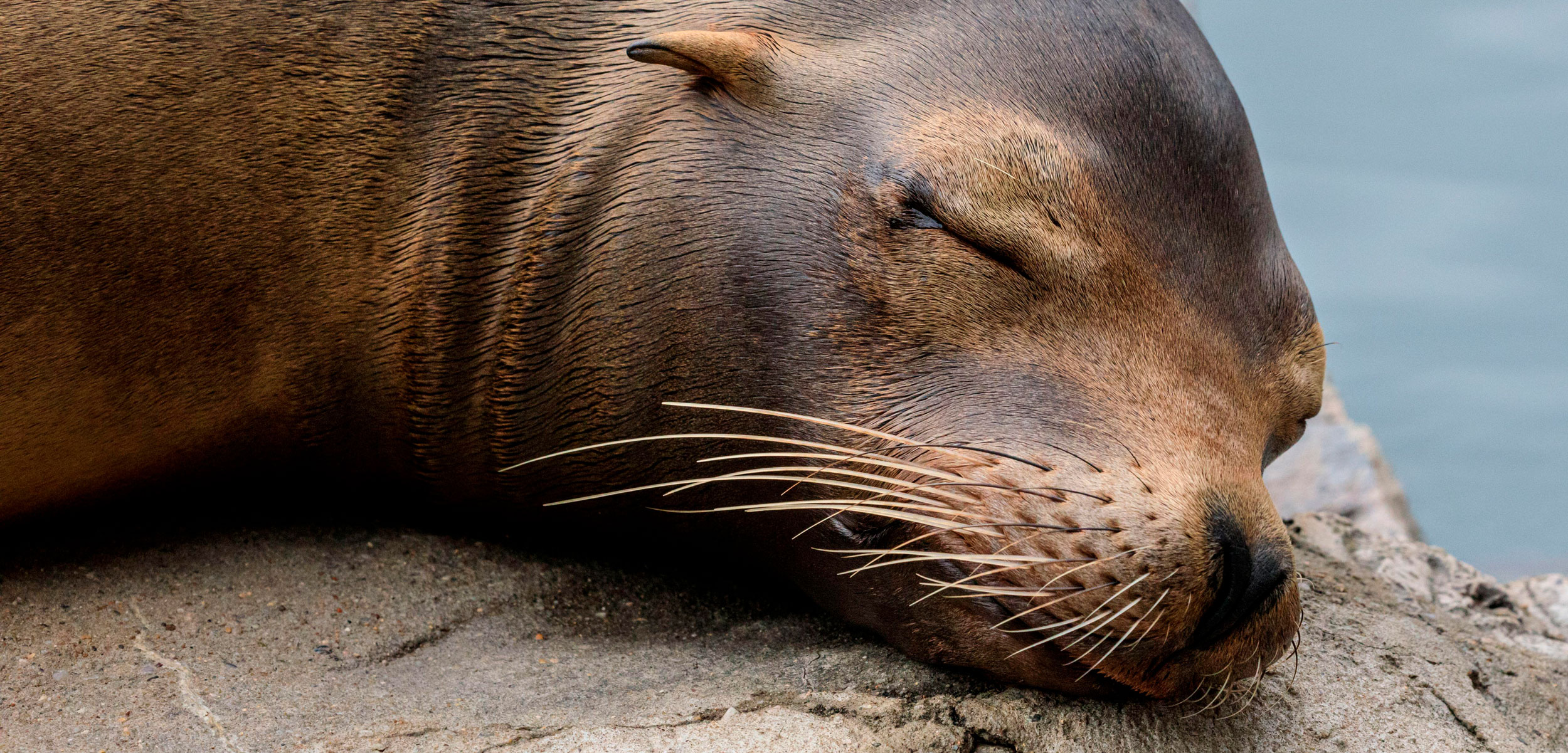How Terrestrial Turds Lead to Marine Maladies
Diseases from land animals are killing marine mammals at an alarming rate. Can we stem the flow of feces?
Article body copy
Pádraig Duignan snaps on a pair of latex gloves in the Marine Mammal Center’s necropsy lab. Located north of San Francisco, California, the lab occupies a space behind a large metal garage door; the door is open on this chilly October day and Pacific Ocean fog surges past. Spread out on a steel table before Duignan are the carcasses of two California sea lions. With a scalpel, he carefully cuts a section of muscle away from the ribs of one of the carcasses and holds a glistening membrane to the lights.
“This is what the diaphragm of a healthy sea lion looks like,” he says, tracing a finger over the tissue. Tight patterns of muscle fibers are interlaced with a mesh of small blood vessels that supply them with oxygen. For a sea lion, an animal capable of diving to depths of over 300 meters, a strong, healthy diaphragm is critical. Duignan reaches below his workstation and retrieves a clear plastic bag. Inside is another slice of diaphragm tissue, different in appearance from the first, taken from an animal suffering from a disease called sarcocystosis.
“Notice the striations,” he says, tracing a finger along the bag. The slab of tissue, suspended in formalin preservative, appears tiger striped, with bright white lines cutting through the dark red muscle fibers. Sarcocystosis can trigger an autoimmune response that causes white blood cells to attack and degrade the body’s muscle cells. “This animal slowly suffocated because its diaphragm was too weak to allow it to breathe,” he says.
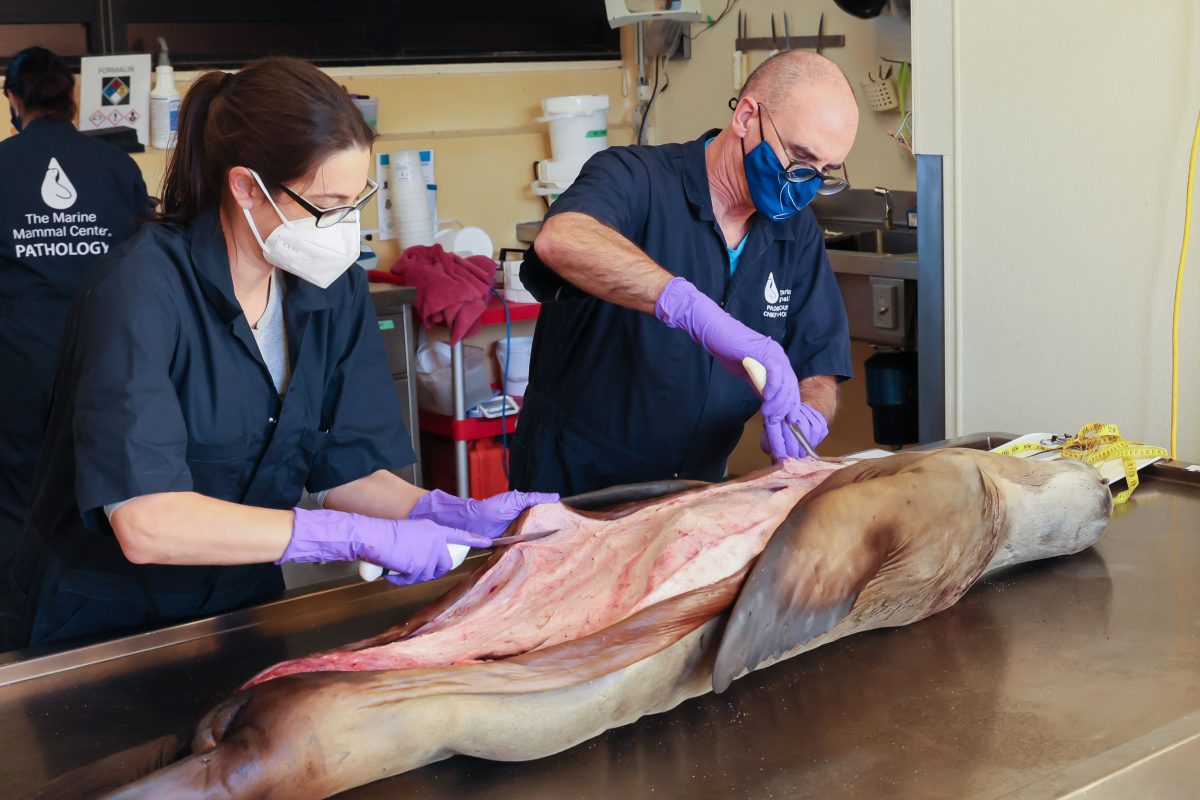
Maggie Martinez and Pádraig Duignan perform a postmortem examination, known as a necropsy, on a California sea lion. Photo by Bill Hunnewell/The Marine Mammal Center
Duignan, the director of pathology at the Marine Mammal Center, is documenting the rising toll that a spate of formerly rare illnesses is taking on marine mammals. Sarcocystosis—caused by a single-celled protozoan called Sarcocystis neurona—in sea lions is strange. Its primary host species, Didelphis virginiana, is not an ocean-faring animal but a denizen of alleys and backyards: the Virginia opossum. The disease is best known in horses, which, in severe cases, show a host of neurological symptoms. Why parasites associated with land animals are showing up with increasing frequency in marine mammals, many of which spend the majority of their lives kilometers from shore, is a medical dilemma to which answers are only starting to emerge.
In 2010, Duignan says, the center had only a single case of sarcocystosis—a California sea lion that came in malnourished and lethargic. But since 2015, the center has taken in more than 100 sea lions and southern sea otters infected with the disease; 32 animals have come in this year alone, nearly double the number from last year.
“We don’t just fatten these animals up and send them on their way,” Duignan says, noting that, in many cases, the animals require weeks, even months, of exhaustive rehabilitation involving hundreds of hours of care from specialized veterinarians and the center’s volunteers. Even with intensive care, the disease often proves deadly. Roughly three out of four sea lions that arrive at the center infected with S. neurona either die in treatment or are euthanized. For sea otters, the mortality rate is even higher.
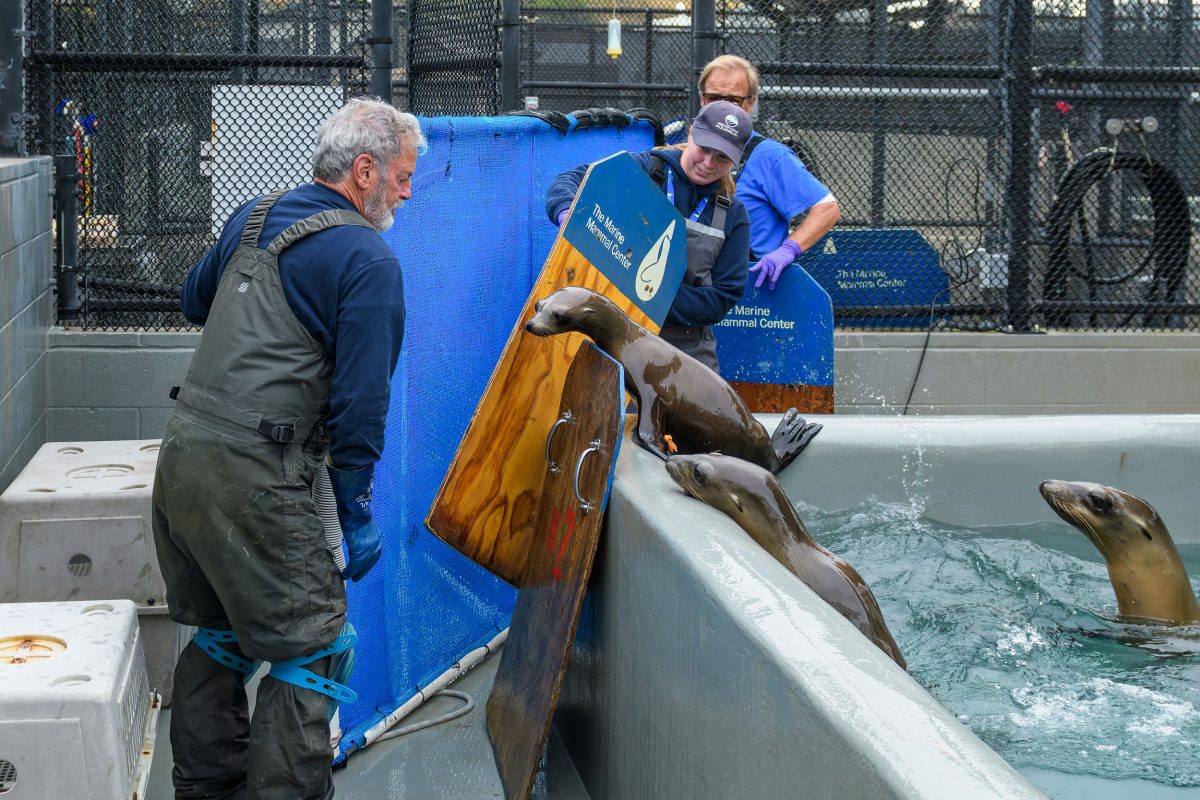
Employees at California’s Marine Mammal Center enter the sea lion enclosure to give one of their charges a health check. Photo by Joshua Asel
Sarcocystosis is only one of numerous terrestrial diseases that infect and kill marine mammals. Last year, an outbreak of leptospirosis, a bacterial disease transmitted by rats, dogs, livestock, and other land animals, caused the death of more than 150 sea lions along the Oregon coast. Brucellosis, another bacterial disease, is often associated with domestic cattle and has been documented in whales and seals along the Alaskan coast, where the pathogen is not passed on by cows but by caribou and reindeer.
One of the most familiar of these land-borne zoonoses is toxoplasmosis, a parasitic disease associated with felines, often referred to as kitty litter disease. Caused by a parasitic protozoan called Toxoplasma gondii, toxoplasmosis can infect a range of marine mammals, from beluga whales in the Canadian Arctic to the endangered Hawaiian monk seal. In a population estimated at less than 1,600 monk seals across the Hawaiian archipelago, toxoplasmosis has claimed the lives of at least 13 in the last two decades. As with other recorded marine mammal mortality statistics, those were only the observed deaths; the total number of deaths among mammals in the open ocean is surely much higher.
Viral diseases are also on the rise across the world’s oceans. In 2013, an outbreak of a type of morbillivirus—the genus of viruses that includes those that cause human measles—killed at least 40 bottlenose dolphins off the coast of southern Australia. Caspian seals, an endangered species restricted to the brackish waters of the Caspian Sea, have been ravaged by canine distemper, a viral disease carried by dogs, coyotes, foxes, raccoons, and other land-based species. One mass outbreak in 2000 killed around 10,000 Caspian seals in Kazakhstan, near the mouth of the Ural River. Along the Baltic Sea, in northern Europe, scientists have documented outbreaks and die-offs of various species of marine mammals, including European harbor seals. The largest of these outbreaks, in 2002, also caused by distemper, killed an estimated 30,000 seals.
More than one-quarter of the world’s marine mammal species are already listed by the International Union for Conservation of Nature as threatened with extinction. Various factors are to blame, including overfishing, maritime traffic, and pollution, and now land-borne diseases, previously overlooked, are attracting more attention—and Duignan is only one of a cohort of veterinarians, pathologists, marine biologists, and volunteers studying them.
Karen Shapiro, an associate professor of pathology, microbiology, and immunology at the University of California, Davis (UC Davis), specializes in aquatic zoonotic pathogens. She says the rise in terrestrial diseases in marine mammals illustrates what she and her colleagues refer to as the land-sea connection, in which urbanization and its attendant alteration of habitat have led to a rise in diseases affecting marine mammals.
Urban and suburban landscapes—with their vacant lots, alleyways, green belts, and various nooks and crannies—provide plentiful safe havens for opossums, feral cats, rats, mice, and dozens of other species that are the terrestrial hosts for an array of pathogens. As cities expand, so, too, do populations of these animals that thrive in human-altered landscapes and are potential reservoirs of disease. Given that 40 percent of the planet’s human population resides within 100 kilometers of a coastline, this is a global problem.

Karen Shapiro’s research in aquatic pathogens—which began with studying “the amazing parasite,” Toxoplasma gondii—has taken her from the University of California, Davis, to the University of Guelph in Ontario and back again. Photo by Joshua Asel
As concrete, asphalt, and other impervious surfaces cover more and more coastal land, pathogens are swept more readily into rivers, streams, and the ocean. This runoff exposes sea lions and other marine mammals, particularly those that live along urban coastlines or at the mouths of major river systems, to a host of pathogens—either directly in the water column or because they have accumulated in the organisms that marine mammals eat. A recent study by Chinese researchers, for example, showed that the prevalence of toxoplasmosis-causing T. gondii in various species of shellfish and fish was two to three times higher in areas that received urban stormwater runoff than in areas that did not.
In the aftermath of this year’s atmospheric river storms in California, rescuers saw a rash of sick sea otters along the outlet of the Pajaro River, near Monterey. The outbreak, Shapiro says, was likely linked to the huge volumes of runoff flowing into the ocean from the agricultural and urban landscapes of the Salinas Valley. Major storms create “flushing events” that expose sea otters, sea lions, and other marine mammals to massive amounts of pollutants and pathogens.
“California has a very distinct dry season and wet season,” Shapiro says. “For months, we have an accumulation of feces from cats, for Toxoplasma, and from opossums, which are the definitive hosts for Sarcocystosis. After the first few rains, all this waste is carried to the coast.”
Climate change has had the unfortunate effect of intensifying the flushing events caused by atmospheric rivers, boosting precipitation and, thus, the amount of runoff ending up in the sea. But that’s only part of the problem. The global ocean has absorbed 90 percent of the excess warming generated by human emissions, and in general, a warmer ocean is a sicker ocean. Higher marine temperatures can lead to massive algal blooms; some of these, like the alga Pseudo-nitzschia australis, have well-documented toxic effects on marine mammals.
Ocean warming seems to be a key driver of marine diseases in nonmammals, especially invertebrates like corals and sea stars. A marine heatwave known as the Blob coincided with a major outbreak of sea star wasting disease from 2013 to 2016, primarily on the Pacific coast, wiping out populations of over 20 sea star species; almost six billion sunflower stars alone were killed from Alaska to Mexico. As Drew Harvell, a professor of marine ecology at New York’s Cornell University, wrote in her 2019 book Ocean Outbreak, “We have created a perfect storm of outbreak conditions … Given the many ways we have mistreated our oceans and made conditions friendlier to microbes, it is no wonder that we are beginning to see more outbreaks of marine diseases.”
For marine mammals, changes in ocean temperature and chemistry caused by a warming climate and pollution may be contributing to immunosuppression, according to Cara Field, the medical director at the Marine Mammal Center. And this, she says, could be making animals more susceptible to sarcocystosis and other diseases. She points to research showing that PCBs in the environment, combined with a herpes virus commonly found in sea lions, can increase the animals’ risk of developing urogenital cancer.
“These contaminants and pollutants often affect our immune systems,” she says. “We know that when an animal’s immune system is compromised, they are more susceptible to disease and severe parasitic infections, which is very concerning.”

Following his recovery from sarcocystosis, Decker the California sea lion is given a last checkup—after being put under anesthesia, a tricky process with sea lions—before being released into the wild. Photo by Joshua Asel
Duignan says that observers of marine mammals in California noticed “a very definite pattern” of leptospirosis infection from the 1970s to the 1990s. “Leptospirosis appeared as an epidemic every three to five years following the El Niño cycle. That was pretty much set in stone. And then climate change happens, and everything changes.” He points to 2018, a year in which sea surface temperatures along the west coast of South America were not anomalously high, according to the National Oceanic and Atmospheric Administration. And yet, hundreds of sick and dead animals, many stricken with leptospirosis, inundated Duignan’s lab. “We were doing 20 necropsies a day on some days. It just came back with a bang.”
To make matters worse, another kind of human pollution may be contributing to the problem. When plastics degrade in the ocean, they break down into particles called microplastics. Research on bivalves has shown that ingestion of microplastics is associated with a reduced capacity to fight off pathogenic bacteria. Shapiro and her team are exploring a different link between microplastics and marine diseases: whether the particles might be acting like tiny rafts, assisting the spread of diseases from freshwater to marine environments.
Other researchers are trying to gauge how easily pathogens can bind with microplastics and disperse across the ocean. If plastic-bound pathogens can ride ocean currents over long distances, then animals or people in remote areas are at greater risk of exposure, Shapiro says. The same is true for bottom-dwelling marine organisms that come into contact with pathogens by way of plastics that sink to the sea floor.
In Santa Cruz, Melissa Miller, a veterinary pathologist with the California Department of Fish and Wildlife, is documenting the impact of sarcocystosis on one of the most iconic and threatened species in California—the southern sea otter. With a population of approximately 3,000 sea otters in all of California, mainly confined to a 450-kilometer section of the central coast comprising a mere 13 percent of the species’ historic range, every death is significant, says Miller.
Sea otters are “in-between” animals, she says. As inhabitants of the margin between land and open ocean, they are, evolutionarily speaking, both terrestrial and marine. Unlike sea lions, sea otters have no thick fat layer to keep them warm, only their dense fur, so they must eat voraciously to sustain their rapid metabolism. A mature sea otter eats about one-quarter of its body weight each day—for a male, this would be around eight kilograms—mainly of shellfish, such as crabs, mussels, and clams. As permanent residents of the intertidal zone, they are key indicators of human impacts on the marine environment.
“They eat the organisms that do the filtering,” Miller says. “And that exposes them to all sorts of harmful things in the water.”
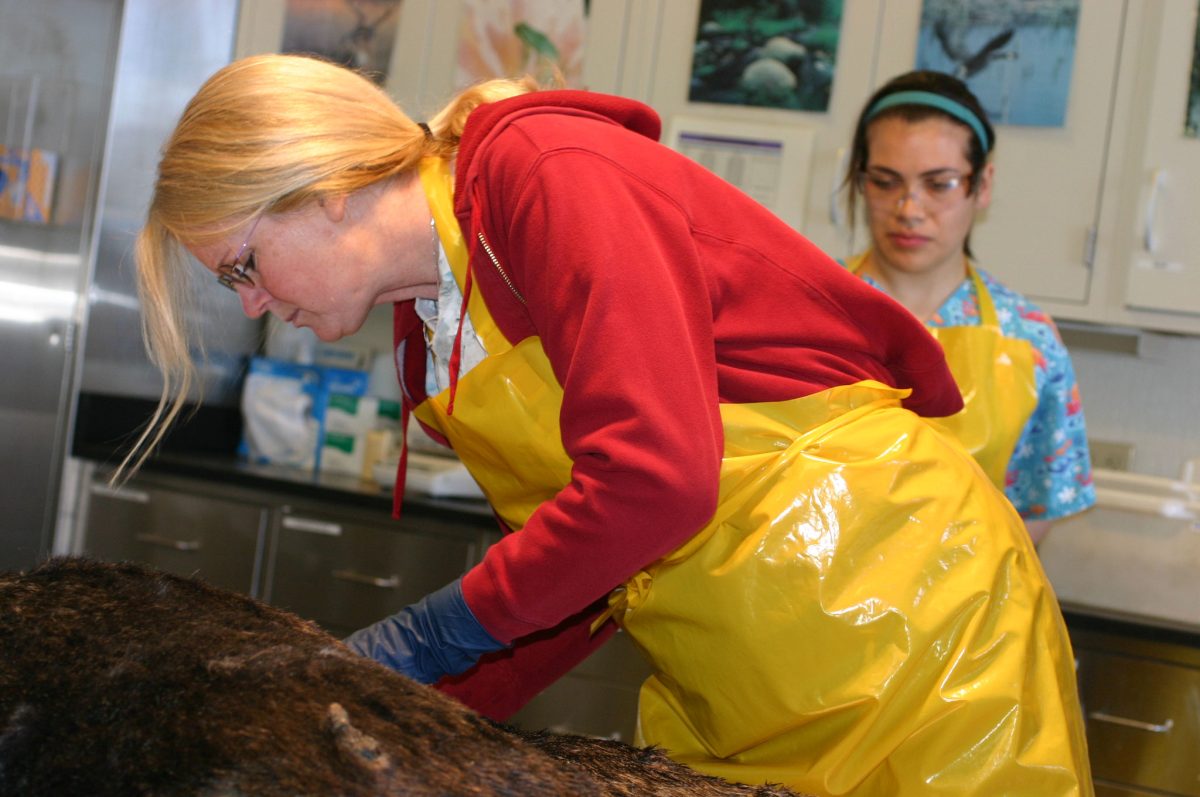
Melissa Miller of the California Department of Fish and Wildlife conducts a necropsy on a sea otter. Photo courtesy of the California Department of Fish and Wildlife
Sea otters are also prone to profilicollis parasites carried in sand crabs. Before young sea otters become proficient divers and harvesters of shellfish, they often forage for this easy-to-find food source by digging through beach sand. “It’s like junk food,” says Miller. “The trade-off is that the crabs are often loaded with these worms.” Many of the sea otters that come into her lab have these parasites, and they can cause serious distress—sometimes punching through the intestinal walls and leading to severe infection in the gut.
“It’s hard being an otter,” says Miller. “These guys are just dealing with so much.”
Miller’s colleague Devinn Sinnott, a PhD candidate at UC Davis, is exploring how sarcocystosis impacts sea otters. They are often infected with both T. gondii and S. neurona simultaneously. In these cases, sarcocystosis is five times more likely to be a primary cause of death than toxoplasmosis, Sinnott says—but because toxoplasmosis is transmissible to people, far more research dollars are devoted to its study. S. neurona is known to infect only non-human animals, says Sinnott, “so a lot less is known about it.”
Complicating matters is the fact that many of these diseases have numerous strains, some of which appear to be more lethal than others. Shapiro and Miller’s research has uncovered a particularly deadly strain of Toxoplasma, its animal origins still unknown. “If a sea otter dies from toxoplasmosis, it’s more likely to be from one of this handful of strains,” Sinnott says. “We hypothesize that perhaps something similar is happening with Sarcocystis neurona—that sea otters that die from it are infected with more virulent or more lethal strains.”
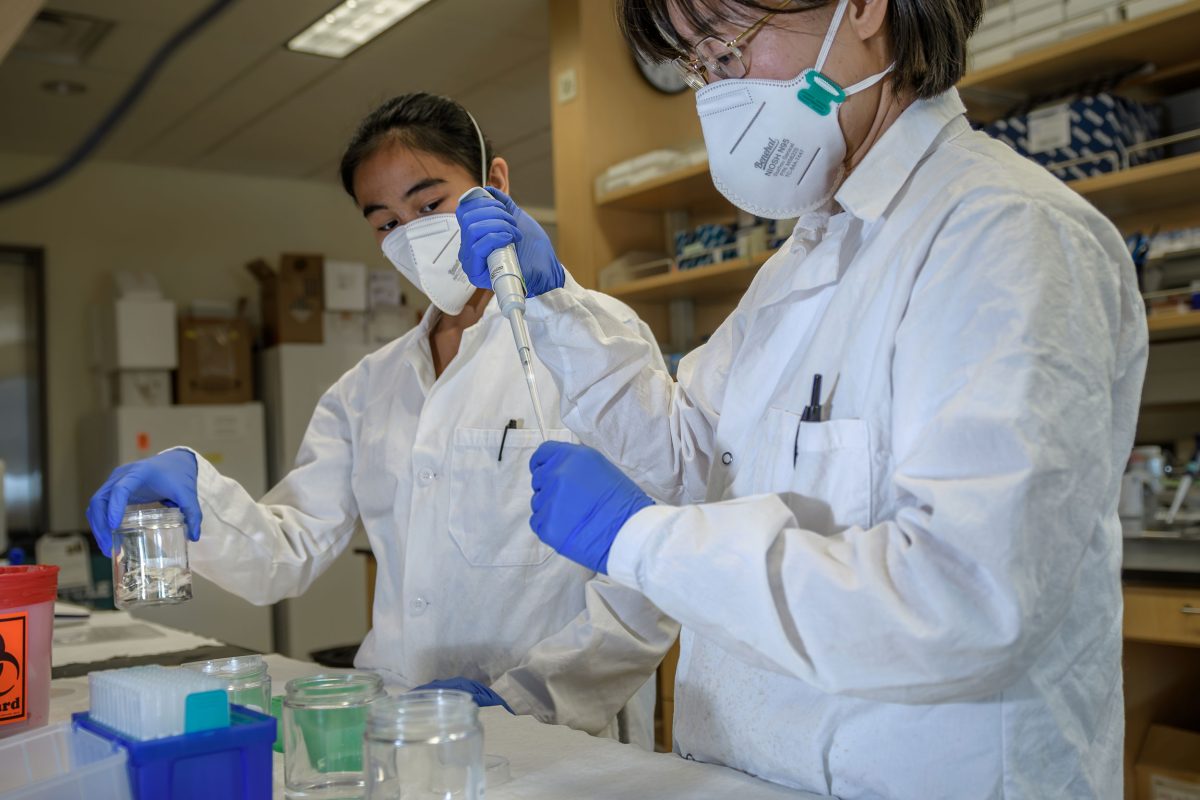
To identify pathogens, researchers at the UC Davis veterinary lab test seawater samples. Photo by Joshua Asel
Diagnoses are made even trickier by the fact that animals often show symptoms attributed to more common maladies, such as malnutrition. Cara Field from the Marine Mammal Center recalls a sea lion named Decker whom she treated back in March 2023. Decker presented with a host of problems, including malnutrition, pneumonia, and a heart murmur, but Field suspected that he had an underlying condition.
Sometimes the cause of an animal’s distress is obvious—shark bites, for example, or entanglement with fishing gear. But Field says that biological complexities often lurk beneath what appear to be purely surface injuries. “Many times, those animals have some other underlying disease that predisposes them to try to find easy food or become less inhibited, maybe causing them to approach people or put themselves in dangerous positions,” she says.
Field’s hunch about Decker was proven correct: he had sarcocystosis. After being medicated intensively throughout a four-month roller-coaster recovery, during which seeming improvements were followed by crashes of malaise, Decker’s symptoms began to abate. In June, he was trucked to the Point Reyes National Seashore 100 kilometers north of San Francisco and released back into the wild.
Though Decker’s release was a small victory, the overall picture remains grim. Field notes that the center’s successful treatment and release rate is far lower than she and her colleagues would like it to be. “We’re still seeing more animals that come in with sarcocystosis die than survive rehabilitation,” she says.
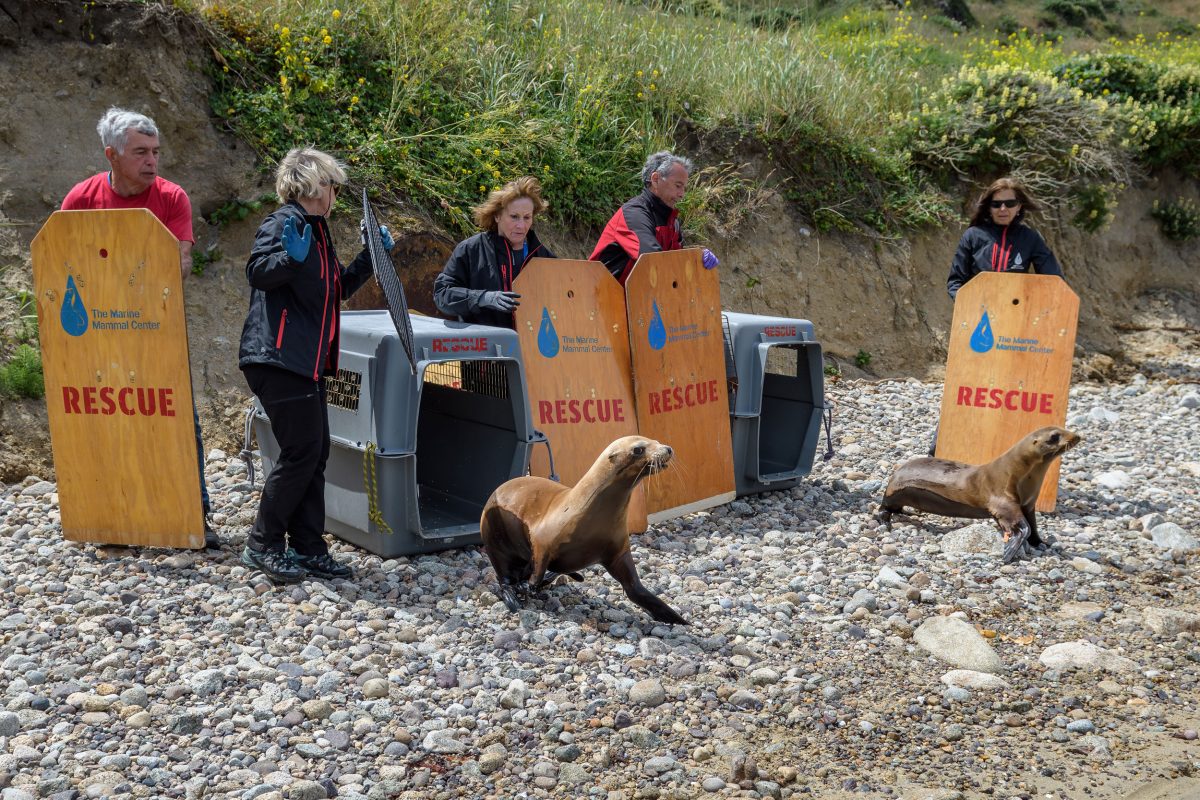
Released from their Marine Mammal Center care, Decker (left) and another juvenile California sea lion galumph toward the waves at California’s Point Reyes National Seashore. Photo by Joshua Asel
Even as the center’s network of first responders grows and care improves, animals will continue dying from these diseases, says Field. And that is because of the diffuse, complex, and global nature of the problem: namely our land-devouring, planet-altering industrial society. “The more that we change and exploit our natural environment,” says Field, “the more we remove those natural barriers that nature has established over eons to help filter out things like these protozoal pathogens.”
One of the most important of these natural barriers, says Sinnott, is wetlands. As much as 21 percent—3.4 million square kilometers—of the planet’s wetlands have been lost since the 1700s, according to a study published earlier this year in Nature. (Previous studies have asserted that the total percentage of wetlands lost in the past three centuries may be as high as 87 percent.) If we continue to drain or destroy coastal wetlands for development or agriculture, Sinnott says, more pathogens like T. gondii and S. neurona will find their way into marine ecosystems. This points to the potential solution: the restoration and protection of wetlands and estuaries.
On that front, there are some hints of movement. In 2019, California’s State Water Resources Control Board adopted new rules to protect the state’s remaining wetland resources from a Trump administration rollback of the Clean Water Act. And last year, the California Department of Water Resources embarked on the Lookout Slough Tidal Habitat Restoration and Flood Improvement Project, the largest tidal wetland restoration in state history. When complete, the project will revitalize over 1,200 hectares of wetlands along a 32-kilometer stretch of tidal channels in the Sacramento-San Joaquin River delta, east of San Francisco. Environmental NGOs ranging from the Sierra Club to California Trout are pushing for even more stringent wetland protections, as well as restoration projects up and down the US west coast.
Of course, to date, humans have shown that we are much more adept at unraveling ecosystems than we are at putting them back together. But if we can bring back even a fraction of the estuaries and wetlands that have been lost—particularly in the lower watersheds of outbreak hotspots like the Pajaro River—we might begin to stem the tide of terrestrial pollution and protect marine mammals from maladies that originate far from shore.

